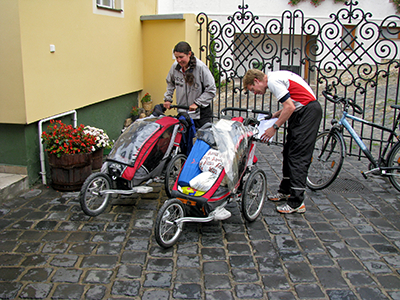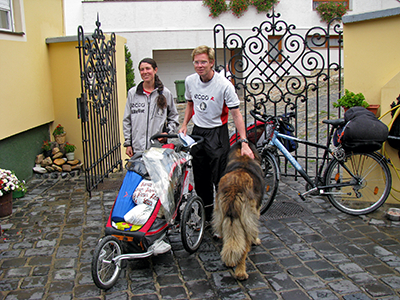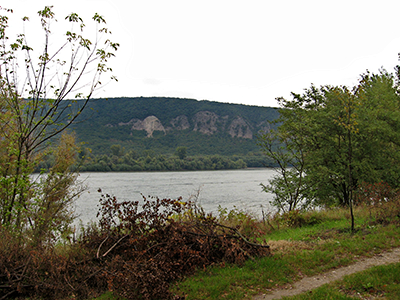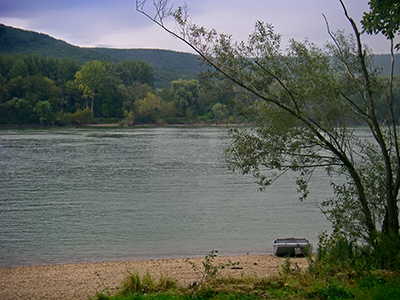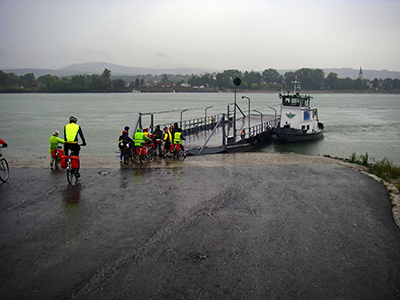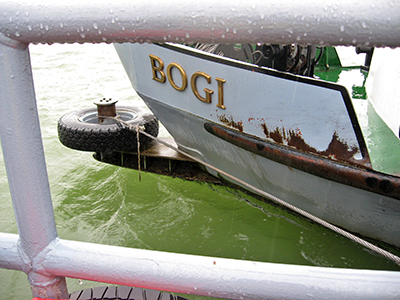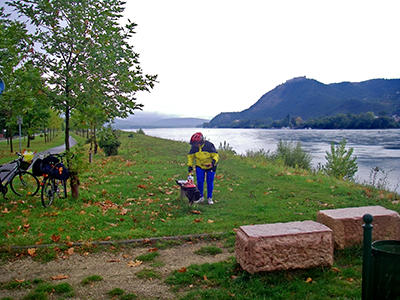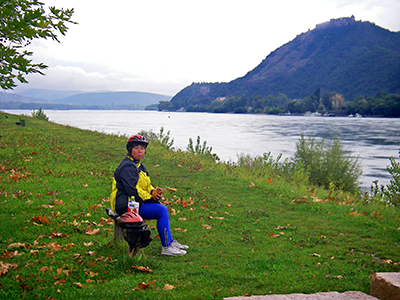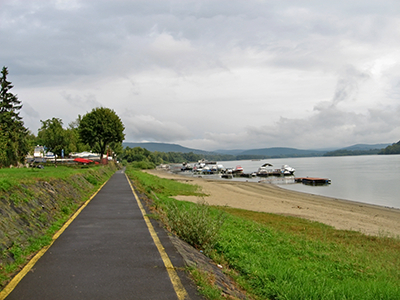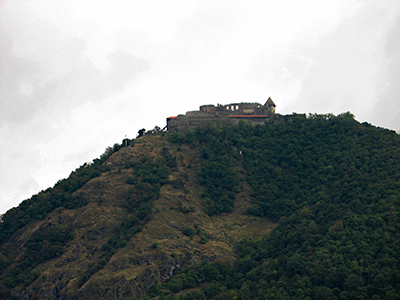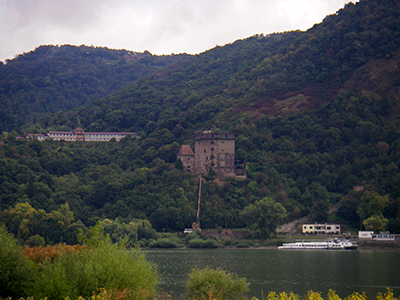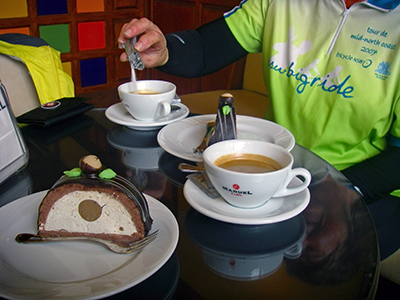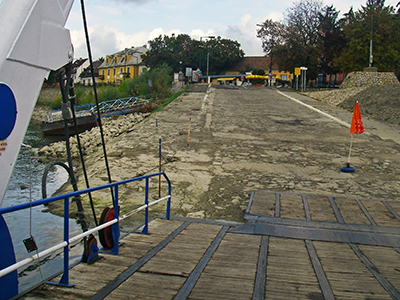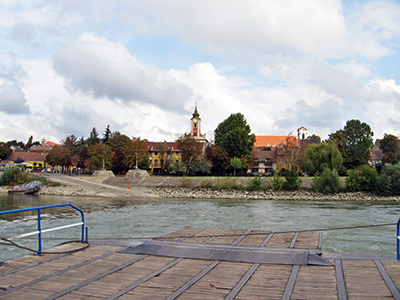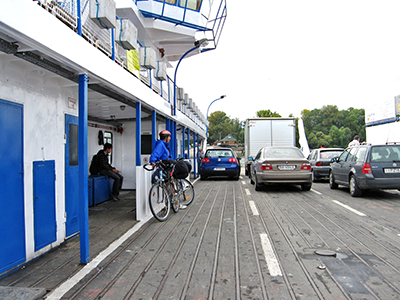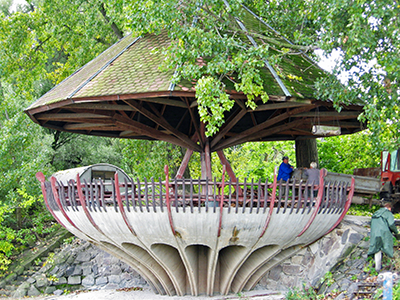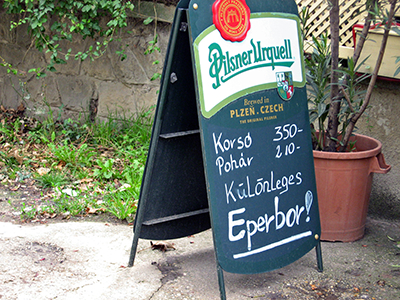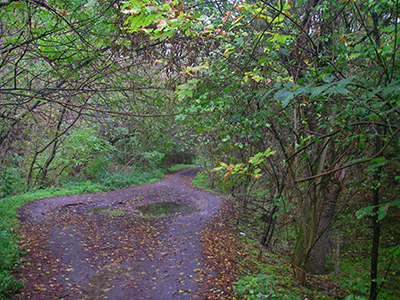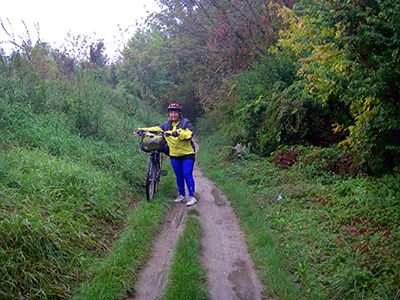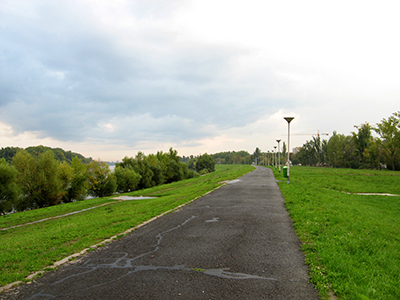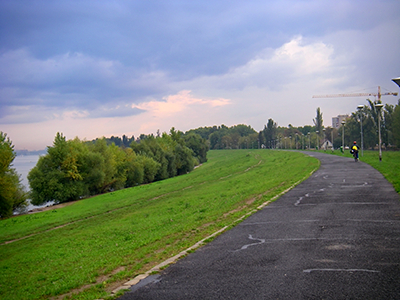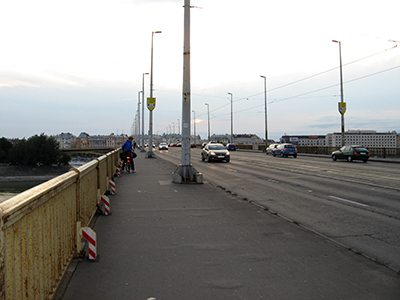Back to Don's Maps
Cycling down the Danube
Day 21, 25th September 2008
Esztergom - Szob - Nagymaros - Kismaros - Szekhegy - Kisvac - Vac - Tahitótfalu - Leányfalu - Szentendre - Budapest

From Esztergom to Budapest 70 km (1212 km from start)
Photo: Google maps
From Maria's Diary:
Esztergom to Budapest
Rainy, cool, and overcast
Met Sarah and her danish friend who are running (with baby trailers) from the North of Norway to Capetown then to the tip of South America to the top of Canada - an amazing journey - will monitor their progress on the web.
Set off late and rode through a total variety of landscapes and surfaces. Rode around edge then joined road - scary to the ferry at Szob.
Timed it nicely and met more Aussies and Americans on Reish Rad group from Vienna to Budapest (baggage sent on to the hotel - bikes provided. ) After crossing over in the rain we headed along the road then a Radweg around the edge of the Donau to Nagymaros.
After this we rode through a small farmlet and past backyards full of interesting fruit trees. At Kismaros we joined the road again and continued on a side Radweg to Szekhegy. Then headed back to the river near Kisvac passing the town of Vac where we took another ferry across (Ft 1600) We now headed inland to the road to Tahitótfalu then to Leányfalu on the other side of the canal, then on past Szentendre.
At this stage we had had enough of the busy road and headed towards the river on a series of BMX type tracks - finally came upon a better track along the banks and entered Budapest. Found a room at Buro Pranzzia in Buda.
Strange pension, Bi&Bi Panzio - ring bell to be let in, € 61 for a double. KFC across the road.

It was rainy, cool, and overcast, and we took a while to get on the road.
I had packed up, and Maria was putting the finishing touches to her handlebar basket which contained our food. We had met Sarah and her Danish friend at breakfast, who took this rare photograph of the two of us together.
In Australia men wear shorts a lot in summer, and I have often noticed the different legs men have, depending on what sport or exercise they do. I have classic bushwalker's legs, solid thighs and calves, especially since I do a lot of climbing up and down the sides of gorges.
In the local Mall on a Saturday, I often amuse myself by identifying the reason for men's particular leg shapes -
'hmmm, he's a very regular cyclist who does a lot of km every week pretty quickly, this bloke jogs long distances nearly every day, the next one spends a lot of time at the gym and never skips leg day, that bloke's a tradie, he's a footballer, and him - well, I don't think he does much except walk from one room to the other.'
Photo: Don & Maria Hitchcock 25th September 2008
Sarah and her friend were running (with baby trailers) from the North of Norway to Capetown, then from the tip of South America to the top of Canada - an amazing journey.
Our bikes were packed up by this stage, about 0845, with my bicycle on the right. This photo is taken from inside the Pension looking out. Outside the gates can be seen the road, a very steep access to the rest of the houses on the street.
Photo: Don & Maria Hitchcock 25th September 2008
Our first sight of the Donau showed that we had moved into a different ecosystem - there were cliffs on the other side of the river, for the first time since the Wachau Valley, upstream of Vienna, on Day 16.
Ten minutes later, the cliffs had retreated a bit, as shown in the right hand photo. At this point we were still on the radweg, but this then funnelled us onto a road, which was not nearly so pleasant.
Anywhere east of Bratislava, you are likely to have to leave a cyclists only radweg with no notice, and fight it out for possession of road space with traffic which gives no quarter.
Photo: Don & Maria Hitchcock 25th September 2008
We took the ferry to Szob, a town in Pest county, Central Hungary, Hungary. It is just south and east of the Slovak border on the north bank of the Danube.
We timed our arrival at the ferry point nicely, and met more Aussies and Americans from the 'Reish Rad' group travelling from Vienna to Budapest (baggage sent on to the hotel - bikes provided.) Maria at the back of the group waiting to board.
I couldn't help notice that although the name of the boat was carefully painted in gold, there were signs of rust elsewhere!
Photo: Don & Maria Hitchcock 25th September 2008
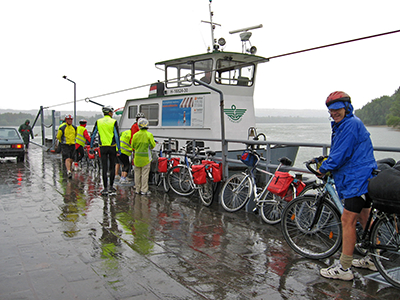
The rain got heavier, and I found that by pulling my hood with attached visor over my head, then attaching my helmet, I could stay reasonably dry above the waist.
The tall bloke in black lycra leggings in this photo was your typical cycling enthusiast - thin, wiry, lots of stamina, and without an ounce of fat. Neither I nor Maria fit that stereotype!
Photo: Don & Maria Hitchcock 25th September 2008
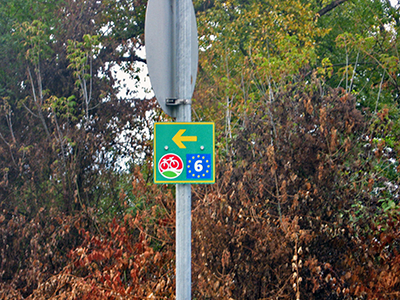
The rain was by now pelting down, and after crossing the river we headed along the road, then turned into a Radweg around the edge of the Donau to Nagymaros.
Photo: Don & Maria Hitchcock 25th September 2008

I was delighted by the beautiful workmanship of the stone piers of this road bridge over a small creek, done in the coursed ashlar style.
The stonemason should have been justly proud of this beautiful example of mastery of the craft.
Photo: Don & Maria Hitchcock 25th September 2008
Thankfully the rain was easing at last - though at this stage, with more clouds looming, we were not sure if it was going to get worse or better!
At least we had a good radweg for a while.
Photo: Don & Maria Hitchcock 25th September 2008
We found a good pulloff with a seat, the rain had stopped for the time being, so we decided to have morning tea. In Hungary it was not easy to find a good cafe for kaffee und kuchen!
Photo: Don & Maria Hitchcock 25th September 2008
The radweg then took us past this shelving beach, with boats and floating wharves.
Photo: Don & Maria Hitchcock 25th September 2008
The hills on the right bank had both relatively modern, large buildings, as well as castle ruins shown in the left hand image, Visegrádi fellegvár, or the Citadel of Visegrad, which has parts that are still being used as exhibition halls detailing the history of the 'High Castle'.
After the Mongol invasion, King Béla IV of Hungary and his wife had a new fortification system constructed in the 1240-50s near the one destroyed earlier. The first part of the new system was the Upper Castle on top of a high hill. The castle was laid out on a triangular ground plan and had three towers at its corners. In the 14th century, at the time of the Angevin kings of Hungary, the castle became a royal residence and was enlarged with a new curtain wall and palace buildings.
Around 1400 King Sigismund had a third curtain wall constructed and enlarged the palace buildings. At the end of the 15th century, King Matthias Corvinus had the interior renovated. The Upper Castle also served for the safekeeping of the Hungarian royal insignia between the 14th century and 1526. In 1544 Visegrád was occupied by the Ottoman Empire, and, apart from a short period in 1595-1605, it remained in Turkish hands until 1685. The castle was seriously damaged by the Turks and was never used afterwards.
The castle is now open to the public to visit.
Photo: Don & Maria Hitchcock 25th September 2008
Additional text: Wikipedia
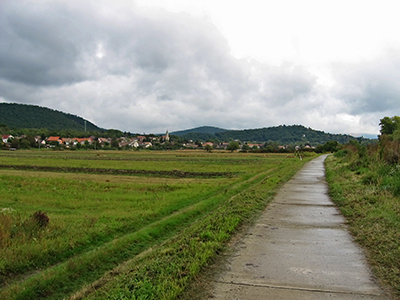
Approaching Kismaros.
It was time for a break, but there was nothing available, so we pushed on, looking for a good cafe, maybe in Verőce, the next small town further on.
Photo: Don & Maria Hitchcock 25th September 2008
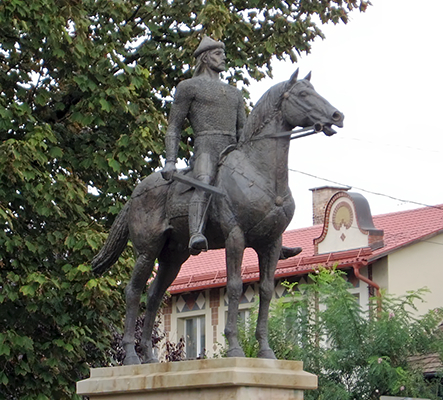
We entered Verőce, and this small but well carved sculpture caught our eye.
It was of Géza (ruled ca 970 – 997), Grand Prince of the Hungarians.
He is shown here astride a horse, wearing chain mail and carrying a sword, and with a Christian cross at his throat. Most sources say that he was a cruel and bloody leader.
Géza, (ca 940 – 997) who was strict and cruel, acting in a domineering way, as it were, with his own people, but compassionate and generous with strangers, especially with Christians, although still entangled in the rite of paganism. At the approach of the light of spiritual grace, he began to discuss peace attentively with all the neighbouring provinces ... Moreover, he laid down a rule that the favour of hospitality and security be shown to all Christians wishing to enter to his domains. He gave clerics and monks leave to enter his presence; he offered them a willing hearing, and delighted them in the germination of the seed of true faith sown in the garden of his heart.
(Text above from Thietmar of Merseburg's chronicle.)
Photo: Don & Maria Hitchcock 25th September 2008
Location: 2 Rákóczi Way, Verőce, Pest County.
Additional text: Wikipedia and Thietmar of Merseburg's chronicle, written between 1012 and 1018.
Across the road from the statue, we found this cafe.
It was the Vén Duna Cukrászda, the Old Danube Confectionery.
Location: Verőce, Árpád út 36.
Photo: Google Street View 2020
We had a delicious coffee and pistachio slice, and gave the establishment five stars!
Photo: Don & Maria Hitchcock 25th September 2008
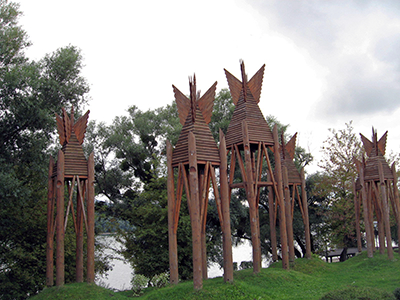
After our Kaffee und Kuchen, we got on our bicycles again, and found these wooden bell towers on the far edge of Verőce, on the bank of the Donau.
The bells were designed by the Kossuth Prize-winning architect Imre Makovecz. The bells ring out tunes three times a day from the music of Béla Tolcsvay.
Photo: Don & Maria Hitchcock 25th September 2008
Location: 5 Árpád Way Verőce, Pest County
Text: Adapted from https://www.termeszetjaro.hu/hu/point/emlekmu/het-vezer-harangja/23260334/
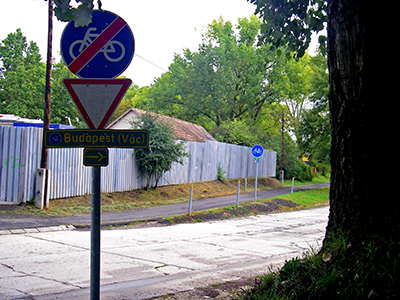
After being on the main road for a while, we were glad to be able to cross over and follow the number 6 radweg sign that we had followed for so long.
We were headed towards Vác and the ferry across the Donau.
Photo: Don & Maria Hitchcock 25th September 2008
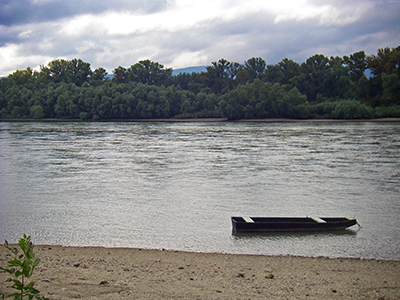
This small boat, moored on the side of a narrow channel of the Donau, with the main flow on the other side of this island, is of a classic design in Eastern Europe and Russia.
It is useful for one or two people to move around the river, and for fishermen. It is cheap and easy to make, and works well.
Photo: Don & Maria Hitchcock 25th September 2008

The radweg was great at this point, near Kisvác, on the outskirts of the town of Vác.
Flat, a good surface, no motor vehicle traffic, and right beside the Donau.
Photo: Don & Maria Hitchcock 25th September 2008
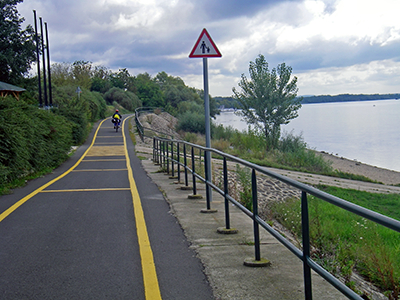
We could see the ferry we wanted to catch just about to dock, around the bend.
The radweg turned and went to the top of the bank, and civilisation, not far after this point, and then took us past a former prison factory.
Photo: Don & Maria Hitchcock 25th September 2008

The radweg went past this wall, facing the Donau, of a factory on the bank of the Donau. Built in 1893, was originally used for the employment of prisoners, which accounts for the heavy steel framing on the windows.
With the construction of this factory building, the prison maintained shoemaking, tailoring, joinery, blacksmithing, toolmaking, bookbinding and printing services. From 1920, it was taken over by a series of private companies for a wide variety of manufacturing activities.
Photo: Don & Maria Hitchcock 25th September 2008
Location of the factory: around the corner from 12 Barabás Miklós St, Vác
Text: adapted from http://www.dunamix.hu/magunkrol/cegtortenet/cegtortenet+2.html
We boarded the ferry just in time for the journey across the Donau, which is about 500 metres wide at this point.
The tall church spire in the centre of the right hand photograph is of the Görög Templom, Vác (the Greek Temple of Vác). It was built at the end of the 18th Century, and dedicated in 1795. The tower was completed in 1805.
It was sold to the city of Vác in 1963, and was at that time in very bad condition. Its actual use as a temple had come to an end, and in the absence of believers, worship was rarely held in the temple even before World War II.
It was renovated by the city, and is now a museum, with occasional temporary exhibitions.
Photo: Don & Maria Hitchcock 25th September 2008
Text adapted from: http://muzeumvac.hu/programok_allando/13/A-Gorog-Templom-Kiallitoterem.html
Most ferry crossings were like this one - a few cars, a few cyclists, occasionally a pedestrian.
It looked as though they had loaded up the left side of the ferry with concrete blocks suspended from the upper railing, in order to counterbalance listing when they had a full load of cars and trucks.
Photo: Don & Maria Hitchcock 25th September 2008
When we disembarked, I was struck by the well made and obviously architect designed ferry waiting terminal here, and the similar, smaller one in the carpark for the ferry, though both looked in need of tender loving care.
Photo: Don & Maria Hitchcock 25th September 2008
We cycled on to Tahitófalu and came on this small shop selling Strawberry Wine, which is a specialty of this district.
The sign on the left reads:
Jug 350
Glass 210
Special
Strawberry wine!
The sign on the right reads:
Special
Quality
Strawberry Wine
Photo: Don & Maria Hitchcock 25th September 2008

Leaving Tahitófalu, the sky became hazy again, and it looked like more rain might be on the way.
Photo: Don & Maria Hitchcock 25th September 2008
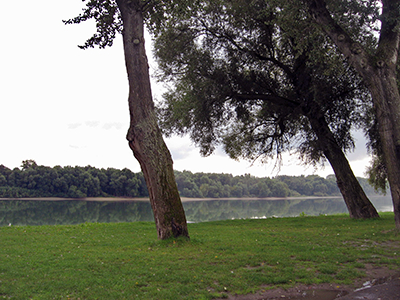
The radweg travelled for a while beside the Szentendrei-Dunaág, which is a small branch of the main Donau, not used much for normal river traffic, as it is shallow.
At Visegrád , on the eastern side of the Danube Bend, it branches off to the right from the main branch, where after about 32 kilometres it rejoins the main branch just above Budapest. The main branch and the Szentendre branch surround a large island, Szentendre Island , and both branches have some smaller islands, peninsulas, and named reefs.
Photo: Don & Maria Hitchcock 25th September 2008
Text: Adapted from Wikipedia
Getting close to Budapest we were dumped back on a busy road, so we headed for the river. We found this muddy and rutted track, part of the radweg system, this part known as the Budakalászi Danube bike path after a nearby village, but used by off-road bicycles (which in Australia we call BMX bikes) which wound around the trees, without apparent design.
Photo: Don & Maria Hitchcock 25th September 2008
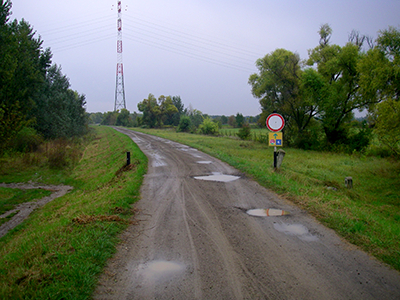
At about 4 pm, the winding track morphed into this much better made track, still with potholes, but adorned with the Number 6 Radweg sign we had been following for three weeks.
Photo: Don & Maria Hitchcock 25th September 2008
Eventually we met this rather grand and well paved radweg beside the last of the Szentendre Island, just before the side branch of the Donau met the main stream above Budapest.
Photo: Don & Maria Hitchcock 25th September 2008
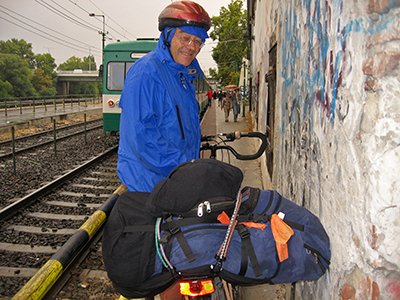
....... And were dumped back into civilisation with a vengeance, somehow winding up on a very narrow platform for a city rail station, from which we extricated ourselves promptly, and went looking for accommodation.
Photo: Don & Maria Hitchcock 25th September 2008
We found a Pension opposite a KFC, piled our bikes one on top of the other in a huge 'cupboard', and Maria got us some KFC.
Worked fine, we had a meal and a good night's sleep.
We had made it.
Next morning we left very early, crossing the bridge to Pest at about 7 am to look for the main train station, since we were going to Romania to visit my good friend there.
The trip turned out to be very difficult indeed, as we had to take regional trains from one small train station to another, since we foolishly decided that we were going to take our bicycles with us to give to our friend.
We should have given them away to anyone who would take them, and taken the fast train to Timișoara. It turned into what we later called 'the train trip from hell'. Trust me, don't take bicycles on the trains from Budapest to Romania. There is no bicycle culture in Slovakia and Hungary and Romania, such as there is in, say, Germany and Austria, and no place to put bicycles except at the end of the very old carriages.
Tipping is expected at every train station, even to buy a ticket, and on every train, tipping is the only way to survive in Hungary and Romania, something I wish we had known before going there, it would have made the journey easier and less stressful.
Photo: Don & Maria Hitchcock 25th September 2008
Cycling down the Danube
Day 21, 25th September 2008
Esztergom - Szob - Nagymaros - Kismaros - Szekhegy - Kisvac - Vac - Tahitótfalu - Leányfalu - Szentendre - Budapest
